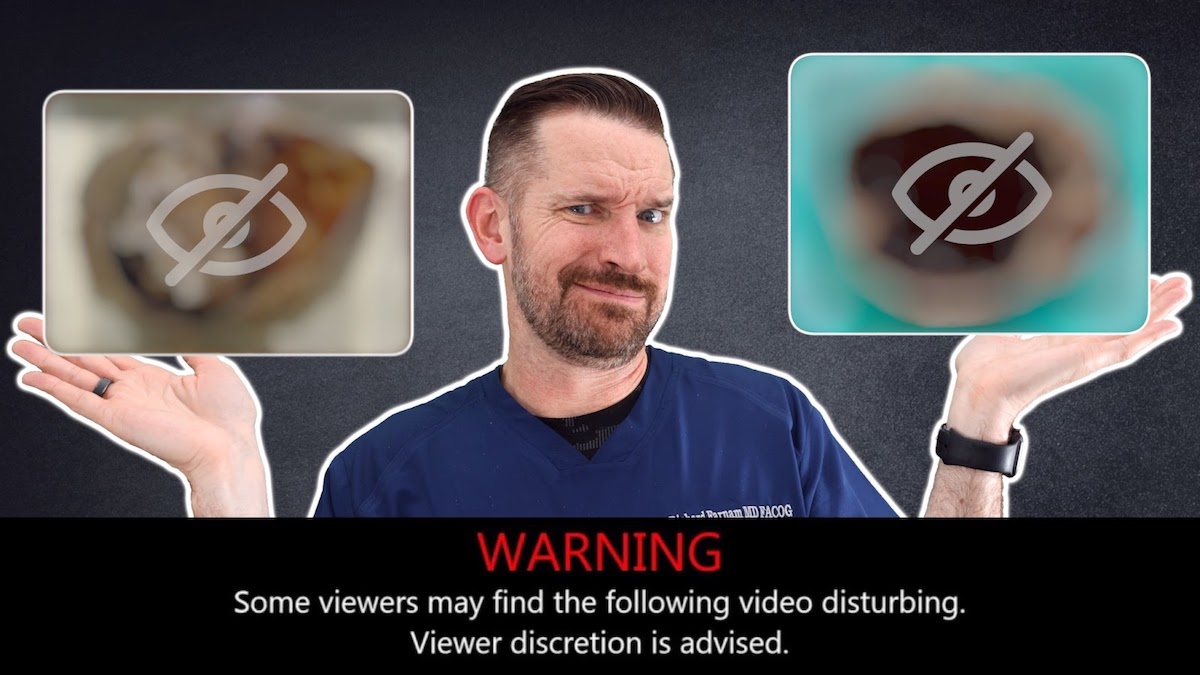It’s November, and you know what that means. That’s right, Bladder Health Month. I’m sure that’s what you were thinking. I mean, who needs Thanksgiving and pumpkin spice lattes when we can talk about bladder health tips.
Don’t have time to read this blog post? Watch it here instead!
Hi, I’m Doctor Rich, and my passion is to empower every woman with practical knowledge about the world of women’s health. Bladder health is a great women’s health topic. I mean, think about it, you don’t really think about your bladder, you take it for granted until you really have to pee. So we’re going to talk about warning signs for different bladder disease conditions, and I’ll share tips to keep a healthy bladder.
So what are the symptoms of an unhealthy or a diseased bladder? So we’re going to talk about a number of things. We’re going to talk about infections, recurrent infections, incontinence, an aging bladder, bladder cancer, and we’re going to discuss tips about how to maintain a healthy bladder. Some individuals that have recurrent urinary tract infections are more than three in six months. So urine infections are one of the most common reasons a woman might go see her ob-gyn provider. Symptoms would include urinary frequency, a sudden urinary frequency, increased urinary urgency, burning with urination, sometimes even blood in the urine.
So if any of these symptoms arise, you should contact your provider, and they’ll take a history and physical exam. Now there are risk factors for someone to get infections and to get recurrent infections. So sexual activity is a common reason. That’s a time period when bacteria that would normally be found in other parts of the body, for example, E. coli is a normal bacteria in the colon, but during sexual activity, some of that flora, some of that bacteria, can ascend and find its way into the bladder. And in the bladder, E. coli is not a normal bacteria and leads to an infection. That’s one example, there are a number of different bacteria that are responsible for infections, but that’s a common one.
Also hygiene, just the simple thing you’ve heard your mom tell you, wipe from front to back. I mean, there’s a reason for this. And when we go the other way, that’s another possibility for normal flora in the colon and anus to be able to ascend into the urethra and cause an infection in the bladder. Other risk factors for urinary tract infections and recurrent urinary tract infections include prolapse. So if the bladder is falling down, that can lead to retaining urine. And the more urine gets retained for a longer period of time, the higher risk of an infection.
Overall, poor health, smoking, these things can lead to urinary infections, as well as there can be anatomic risk factors. So some women have what’s called a short perineal body, and that’s just the distance between the posterior part of the vagina and the anterior part of the anus. When that physical distance is shorter, that’s going to be increased risk. And one of the things that oftentimes gets overlooked is what’s called a urogenital atrophy.
So women in their mid, late fifties will go through menopause. And menopause basically is a withdrawal or a reduction in the amount of hormones that are produced by the ovaries. Well, those hormones, that estrogen, in the vaginal tissue and around the bladder, helps maintain a protective layer of bacteria within the vagina that prevents bacteria, abnormal bacteria from rising or ascending into the bladder.
So estrogen by itself has been clinically proven, in that age population, to reduce the risk of recurrent infections. So most infections are easily treated with a short course of antibiotics. Certainly, if you have recurrent infections, you definitely need to see your provider to determine which risk factors you have that might be treated differently. Again, we mentioned prolapse. Sometimes there has to be a correction, an anatomic correction. And with a low estrogen state, sometimes estrogen cream.
So in an elderly population, if you’re caring for a loved one, or really anybody who is getting more than three infections in six months, definitely would want to see a specialist, a provider, that can actually do a complete evaluation, either an ob-gyn or urogynecologist.
So now we know what UTIs are, how do we prevent them, and what dietary things can we do just to maintain a normal, healthy bladder? Well, beyond antibiotics and the other treatments that we mentioned, like estrogen in a post-menopausal population, cranberry juice or cranberry pills have been shown to have some effectiveness in preventing infections. Methenamine is another medicine that can be used to prevent infections. But really just good toileting habits. So don’t hold your bladder for extended periods of time. You should probably be going every couple of hours. If you go nine, 10 hours without emptying your bladder, you’re probably allowing for your bladder to become abnormally distended, and this can lead, over a long time, to urinary retention and urine infections.
So what dietary things should we avoid? So definitely no smoking. In general, that’s a main thing that you want to do for promote good health and immune system, but specifically, it affects the bladder. You want to limit the intake of caffeine and alcohol. Also artificial sweeteners, sodas, you want to stay away from all that.
So what are dietary supplements or dietary choices that do maintain a healthy bladder? So it’s just like your grandmother told you, healthy diet, fruits, vegetables. A number of fruits are powerful antioxidants. So blueberries, cranberries, these can lead to overall healthy bladder. And in general, a healthy, balanced diet. You want to make sure you’re getting adequate amounts of dietary fiber, natural sources of fiber, as well as protein. And really, the one element that is the most important is hydration. When we run around all day, and we’re busy, and we’re not drinking water, that’s going to increase our risk of infections.
Everybody’s fluid intake is going to be different. It’s going to be based on their volume of distribution and their individual body calculation. But in general, you want to drink about eight, eight ounce glasses of water a day. And you can’t do it all at once. The body has no ability to store water. So whatever you drink, your body will replenish what it needs, and the rest of it will be immediately excreted. So you can’t drink two gallons in the morning and then you’re good for the day. So you have to really continuously make it a habit of drinking throughout the day. Not just your bladder health, this is good for your overall immune function. Some people have fatigue and headaches, and really they’re just dehydrated. So that is probably the central principle if we took anything away from today is make sure you’re staying hydrated.
So what other bladder issues can arise commonly? We talk about incontinence, so the leakage, the involuntary leakage of urine. And there are a number of different things that can cause incontinence, there’s different risk factors, there’s different disease processes. We’ve mentioned this in prior videos that we’ve done, and we’re going to do a number of other videos on the topic. So suffice it to say, that incontinence is extremely common, as many as 35% of women will have incontinence in their lifetime. And in most cases, there are simple treatments. As a preventative strategy, there’s something called Kegal exercises, where it’s an exercise, but essentially it’s to contract the muscles in the pelvic floor, and over time that can actually improve the leakage. And there are many other treatments and workups that we’ll save for separate videos that you can find here.
One of the other common problems is bladder prolapse. So bladder, actually it becomes weak and falls down into the vagina. It can even come outside of the body. So at that point, you would definitely want to seek treatment, which basically comes down to exercises, pessary devices, or surgery to correct that. Again, we have other segment on this, another video, so stay tuned for that one.
Another common condition of the bladder is known interstitial cystitis or painful bladder syndrome. And essentially, the bladder wall is lacking a certain component called glycosaminoglycan. And what this allows for is the normal storage contents of the bladder, normal ions that would not affect somebody else become very irritative. And somebody feels, basically they constantly have a urinary tract infection. They have urgency, frequency, burning when they urinate, sexual pain.
So we’ll do another segment on this topic specifically, but there are dietary recommendations that specifically help with the interstitial cystitis. We’ll include a link in the section below, but essentially you want to avoid the smoking, caffeine, anything that has based with tomato or tomato paste, you want to avoid that and spicy foods. Those are the things to avoid. And the other generally healthy bladder fruits and vegetables we talked about earlier.
Ironically, cranberry, which we had mentioned is helpful for UTIs, in some cases actually exacerbates interstitial cystitis. And we would also want to talk about bladder cancer. So this is a relatively rare condition, but it’s something that the warning signs shouldn’t be ignored. So blood in the urine, either gross blood that you can see with the eye or on a dipstick. We want to, if someone’s getting recurrent infections, and they’re noted to have blood, that’s something that would require a further workup.
There are a number of risk factors for bladder cancer, smoking… We’re finding a recurrent theme here, so definitely shouldn’t smoke. If there’s a family history, there can be an inherited gene defect that leads to bladder cancer, chronic infections, chronic catheter utilization. There are a number of different types of bladder cancer. The most common is from the urothelium [inaudible 00:12:22] transitional cell cancer. But if you have blood in the urine, recurrent infections, new onset back pain, family history, this is definitely something that you would want to see your provider for a complete workup.
So that is your brief Bladder Health Awareness Month tutorial. I hope you found this information helpful. If you did, please share now. Also, please subscribe, and make sure to check out some of our other great content.




